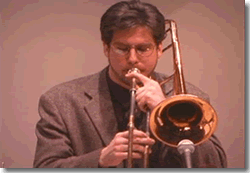
The harmonic minor scale is considered by some to be the homely sister of the elegant and useful melodic minor. Yes, it's kind of clunky. Yes, it makes you want to the do the snake charmer dance. Just like the melodic minor the harmonic minor scale generates some modes that are very useful for improvisation. Here they are:
- On a C- maj7 you would play a harmonic minor from the root
- Over a minor ii/V you would play harmonic minor from the I:
A more modern sound would be to play a melodic minor from the b3rd
G7b9 *C harm- starting on G (up a fourth) G.Ab.B.C.D.Eb.F (root, b9 ,3 ,11 ,5 ,b13 ,b7)
This is a classic Bebop approach to V7b9 chords (some call this scale an Augmented-Phrygian). Bird used this scale on minor tunes all the time and it is distinctly pre-Trane bop. The altered dominant (whole-half) scale for the most part supplanted this sound in post-bop .
- Over a Maj 7th chord you can play a harmonic minor scale from the third (Yes, the third)
This is called a Split Third Major Scale. Of course You wouldn't want to hang out on the #9.
This scale is very close to the Symetrical Major Scale, which is made up of three major triads a major third apart (C, Eb, E, G, Ab, B) or C triad+E triad+Ab triad.
- Over minor 9(b5) you can play a harmonic minor starting on the fifth.
You could call this a Minor Lydian/Mixolydian scale.
- Over a Maj 9 (#5) chord you would play harmonic minor down a minor third.
This is called a Major Augmented Scale. Notice the clunky natural 11, a melodic minor scale from the same root would give you a #11 instead.
- Over a diminished 7 (b9) chord you would play a harmonic minor scale up a half step.
OK, this is really pushing it but you could think of this scale as an alternative to the Altered Dominant scale.
Obviously some of these scales are more useful than others, and most are not quite as hip as their melodic minor counterparts. These scales do offer some different flavors to add to your harmonic pantry.























